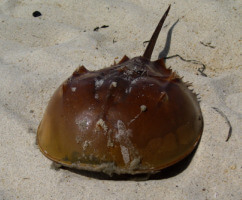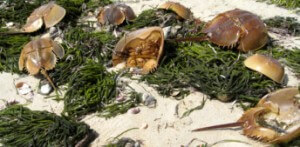Horseshoe Crabs: An Appreciation
It’s pretty much undisputed that Memorial Day kicks off summer. When I think of summer, I think of the beach. And who among us hasn’t encountered a horseshoe crab while strolling along the sand? Especially if you’re hanging out along the East Coast.
I admit I’ve always been a little fearful of those primitive crustaceans with their spear-like tail poking out of the sand, threatening to impale a barefoot beachcomber. I’ve never fallen victim, but I know people who have.
While researching a story for this season’s All Things Connecticut (on CPTV), I recently learned that horseshoe crabs are not to be feared – unless of course you step on one – but rather respected. In fact, they play a critical role in the pharmaceutical industry. Horseshoe crabs have a compound in their blood (which is a shocking shade of blue) that causes it to instantaneously clot in the presence of contaminants. This compound, which is called Limulus Amoebacyte Lysate or “LAL” for short, is used by every pharmaceutical company in the world to test for the presence of bacteria in their medicine and vaccines. In fact, I was recently at Protein Sciences in Meriden, which manufactures the H1N1 Vaccine, where they were conducting “LAL” tests before releasing the vaccine to the public. Quite amazing, really.
But it’s how the “LAL” is extracted from the humble horseshoe crab that is truly eye-opening. The unsuspecting creatures are pulled from their natural habitat, brought to the labs where “LAL” is synthesized, drained of most of their exotic blood, and then tossed back into the wild. Sink or swim. While, the generally accepted statistic on survival rates after a “bleeding” hovers at 10-percent, when you actually witness the proceedure, that does seem a little dubious.
Protecting people from tainted drugs – not the only medical miracle these primitive creatures perform: the chitin in their shells is used for sutures and healing burns, and they’ve been involved in nobel prize winning eye research. As one enamored horseshoe crab researcher affectionately told me, “Horseshoe crabs just keep on giving and giving and giving.”
This researcher, Dr. Carmela Cuomo from University of New Haven, is in the midst of a major scientific breakthrough that will likely ensure that we preserve this prized species despite their high demand. After 10 years of diligent work, she managed to breed and raise the crabs in captivity, keeping them alive longer than any other scientist in the world. She generously gave me and my two sons some “newborn” crabs to try to raise as pets at home, conducting our own little experiment. They died within the week. (Just another reminder of why I’m a journalist and not a scientist.) But, under Dr. Cuomo’s loving care, her little beauties are well into their second year of life. And, despite their teeny, tiny size, they are the spitting image of their spider-like parents. If you want to see for yourself, check out my segment that is airing on CPTV’s All Things Connecticut by clicking here.
Another tidbit of information on my new favorite sea creature: when you see their shells littering the beach, don’t mourn another untimely horsehoe crab death by bleeding. Chances are, what you’ve stumbled upon is the empty shell of a crab who has merely outgrown his “crib.” Just like the lobster, these guys moult and then move on. I told you they were cool.
Christina DeFranco, Environmental Journalist | CT Documentary and Video Producer



